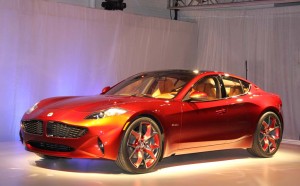Investors will be watching closely to see how the increasingly troubled battery maker A123 Systems’ stock performs this morning. Its shares surged 52% before the final market bell rang on Tuesday.
The company, which only recently acknowledged there was “substantial doubt” about its viability, may be in the midst of a significant reversal of fortune after revealing it has come up with a major breakthrough in battery technology. That development should lower costs and make it easier to design and produce battery-electric vehicles while also expanding opportunities for battery technology in the telecommunications industry.
The revised version of A123’s battery chemistry couldn’t come along at a better time. The Massachusetts-based firm has faced a variety of problems in recent months, including the recall of batteries it produced for plug-in hybrid maker Fisker Automotive due to a manufacturing defect.
The reported breakthrough involves a revised version of A123’s phosphate-based lithium-ion battery chemistry, which it is calling Nanophosphate EXT. Lithium technology has the highest energy-density – the amount of power it can store in a given mass – of any battery chemistry in production today. But it traditionally has a number of problems that limit its range and raise its costs.
Among other things, lithium likes to operate in a limited temperature band, so most manufacturers have to build costly climate control systems into their battery packs, which also adds weight and can reduce range.
But the new Nanophosphate EXT battery reportedly can tolerate much more extreme temperature ranges, according to A123.
“By delivering high power, energy and cycle life capabilities over a wider temperature range, we believe Nanophosphate EXT can reduce or even eliminate the need for costly thermal management systems, which we expect will dramatically enhance the business case for deploying A123’s lithium-ion battery solutions for a significant number of applications,” said A123 CEO David Vieau.
Even at temperatures of 113 degrees Fahrenheit (45 degrees Celsius), the new chemistry will retain 90% of its initial capacity for at least 2,000 full charge/discharge cycles, according to A123 testing. And in cold climates reaching as low as -22F, or -30C, where batteries are largely unusable, it will deliver a 20% boost in power, according to A123 tests. And that is without the use of battery heaters or coolers.
.”Based on our analysis, the performance of A123’s new Nanophosphate EXT at high temperatures is unlike anything we’ve ever seen from lead-acid, lithium-ion or any other battery technology,” said Dr. Yann Guezennec, senior fellow at the Center for Auto Research and professor of mechanical engineering at Ohio State University, who oversaw testing of the new technology.
While A123 did not provide specific details industry sources contacted by TheDetroitBureau.com suggested that it could yield $100s, perhaps $1000s of dollars in savings for a vehicle using the Nanophosphate EXT technology by eliminating the need for a battery pack climate control system. And the lower weight could translate into either added range or the ability to downsize the pack to deliver the same distance per charge.
But it also remains to be seen how much expensive the new chemistry will be. The challenge for all battery manufacturers has been to drive down costs to make battery-electric vehicles, plug-ins and conventional hybrids more competitive with traditional gas and diesel power.
If A123 can deliver a real price break and get the new technology into production in a hurry it could be the breakthrough the company needs.
Its fortunes have been on a slide even as more and more customers put A123 batteries into production. The firm lost $257.7 million for 2011, a 69% year-over-year increase. Following a first-quarter 2012 loss of $125 million – a 133% increase from the year before – it warned there was “substantial doubt” about its long-term future.
That sent its stock plunging. The battery maker ultimately saw a 52-week low of just 82 cents, off from a high of $5.91.
Complicating matters, the company acknowledged a manufacturing defect at a plant in Michigan forced it to recall batteries supplied to a number of automakers. The only one formally identified by name was Fisker, which discovered the problem when a car being tested by Consumer Reports magazine suddenly went into fail-safe mode.
Nonetheless, A123 has continued investing, helped by a $249.1 million federal grant it received in August 2009.
(Critics of the energy program have cited A123’s problems as one reason to oppose government-funded green energy loans and grants. It remains to be seen if the breakthrough will now serve as a case in point for the program’s proponents.)
After laying off workers in 2011 the company is now in the midst of hiring 400 in Michigan – in part due to requirements set down as part of state and federal financial aid it received.
The firm is not stating when the Nanophosphate EXT battery will go into production, nor in what vehicles. A123 is known to have as many as a half-dozen automakers as customers, however, including Fisker as well as General Motors. The latter will use its batteries in the upcoming Spark EV model.

